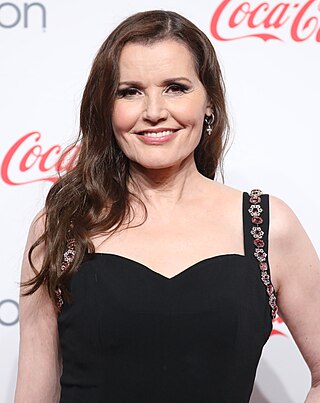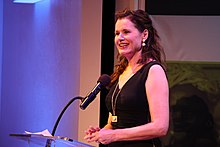
Richard Semler Barthelmess was an American film actor, principally of the Hollywood silent era. He starred opposite Lillian Gish in D. W. Griffith's Broken Blossoms (1919) and Way Down East (1920) and was among the founders of the Academy of Motion Picture Arts and Sciences in 1927. The following year, he was nominated for the Academy Award for Best Actor for two films: The Patent Leather Kid and The Noose.

Virginia Elizabeth "Geena" Davis is an American actor and activist. She is the recipient of various accolades, including an Academy Award and a Golden Globe Award.
Gay-for-pay describes male or female actors, pornographic stars, or sex workers who identify as heterosexual but who are paid to act or perform as homosexual professionally. The term has also applied to other professions and even companies trying to appeal to a gay demographic. The stigma of being gay or labeled as such has steadily eroded since the Stonewall riots began the modern American gay rights movement in 1969. Through the 1990s, mainstream movie and television actors have been more willing to portray homosexuality, as the threat of any backlash against their careers has lessened and society's acceptance of gay and lesbian people has increased.

Ethnic pornography is a genre of pornography featuring performers of specific ethnic groups, or depictions of interracial sexual activity.
Women's cinema primarily describes cinematic works directed by women filmmakers. The works themselves do not have to be stories specifically about women, and the target audience can be varied.
The celluloid ceiling is a metaphor for the underrepresentation of women in hiring and employment in Hollywood. The term is a play on the metaphor of the "glass ceiling", which describes an invisible barrier that keeps a given demographic from rising beyond a certain level in a hierarchy. Celluloid refers to the material used to make the film stock that was once used to make motion pictures. The term is usually applied to behind the screen workers only.
Gender inequality is the social phenomenon in which people are not treated equally on the basis of gender. This inequality can be caused by gender discrimination or sexism. The treatment may arise from distinctions regarding biology, psychology, or cultural norms prevalent in the society. Some of these distinctions are empirically grounded, while others appear to be social constructs. While current policies around the world cause inequality among individuals, it is women who are most affected. Gender inequality weakens women in many areas such as health, education, and business life. Studies show the different experiences of genders across many domains including education, life expectancy, personality, interests, family life, careers, and political affiliation. Gender inequality is experienced differently across different cultures.

Cross-gender acting, also called cross-gender casting or cross-casting, refers to actors or actresses portraying a character of the opposite sex. It is distinct from both transgender and cross-dressing character roles.

An actor or actress is a person who portrays a character in a production. The actor performs "in the flesh" in the traditional medium of the theatre or in modern media such as film, radio, and television. The analogous Greek term is ὑποκριτής (hupokritḗs), literally "one who answers". The actor's interpretation of a role—the art of acting—pertains to the role played, whether based on a real person or fictional character. This can also be considered an "actor's role", which was called this due to scrolls being used in the theaters. Interpretation occurs even when the actor is "playing themselves", as in some forms of experimental performance art.

The Bechdel test, also known as the Bechdel-Wallace test, is a measure of the representation of women in film and other fiction. The test asks whether a work features at least two female characters who have a conversation about something other than a man. Some versions of the test also require that those two female characters have names.
The presence of African Americans in major motion picture roles has stirred controversy and been limited dating back decades due to lingering racism following slavery and segregation. "Through most of the 20th century, images of African-Americans in advertising were mainly limited to servants like the pancake-mammy Aunt Jemima and Rastus, the chef on the Cream of Wheat box." While African American representation in the film industry has improved over the years, it has not been a linear process; "Race in American cinema has rarely been a matter of simple step-by-step progress. It has more often proceeded in fits and starts, with backlashes coming on the heels of breakthroughs, and periods of intense argument followed by uncomfortable silence."
The exploitation of women in mass media is the use or portrayal of women in mass media such as television, film, music, and advertising as objects or sexual beings, in order to increase the appeal of media or a product to the detriment of the women being portrayed, and women in society. This process includes the presentation of women as sexual objects and the setting of feminine beauty ideals that women are expected to reflect. Sexual exploitation of women in the media dates back to 19th century Paris, in which ballerinas were exposed to harassment and objectification. The most often criticized aspect of the use of women in mass media is sexual objectification, but dismemberment can be a part of the objectification as well. The exploitation of women in mass media has been criticized by feminists and other advocates of women's rights, and is a topic of discussion in feminist studies and other fields of scholarship.
In South Korea, gender inequality is derived from deeply rooted patriarchal ideologies with specifically defined gender-roles. While it remains especially prevalent in South Korea's economy and politics, gender inequality has decreased in healthcare and education.
Gender plays a role in mass media and is represented within media platforms. These platforms are not limited to film, radio, television, advertisement, social media, and video games. Initiatives and resources exist to promote gender equality and reinforce women's empowerment in the media industry and representations. For example, UNESCO, in cooperation with the International Federation of Journalists, elaborated the Gender-sensitive Indicators for Media contributing to gender equality and women's empowerment in all forms of media.

Women are involved in the film industry in all roles, including as film directors, actresses, cinematographers, film producers, film critics, and other film industry professions, though women have been underrepresented in creative positions.
The Geena Davis Institute on Gender in Media is a US non-profit research organization that researches gender representation in media and advocates for equal representation of women and men.

Asia Kate Dillon is an American actor. They are known for their roles as Brandy Epps in Orange Is the New Black and Taylor Mason in Billions. Dillon identifies as non-binary and uses singular they pronouns. Their role on Billions is the first non-binary main character on North American television, and earned them a Critics' Choice Television Award nomination for Best Supporting Actor in a Drama Series. They also played the Adjudicator in the action film John Wick: Chapter 3 – Parabellum (2019).

African American cinema is loosely classified as films made by, for, or about Black Americans. Historically, African American films have been made with African-American casts and marketed to African-American audiences. The production team and director were sometimes also African American. More recently, Black films featuring multicultural casts aimed at multicultural audiences have also included American Blackness as an essential aspect of the storyline.
The Original Six are a group of women directors who created the Women's Steering Committee (WSC) of the Directors Guild of America (DGA). Dolores Ferraro, Joelle Dobrow, Lynne Littman, Nell Cox, Susan Bay Nimoy and Victoria Hochberg formed the Women's Steering Committee of the Directors Guild of America in 1979. They carried out landmark research showing that women held only 0.5% of directing jobs in film and television, which they reported to the Guild, the studios and the press.
Sexism in Bollywood refers to gender discrimination and stereotyping prevalent in the Hindi film industry of India, commonly known as Bollywood. This includes the portrayal of women in films, gender disparities behind the camera, and broader issues of representation and bias.
Lawrence, Amy. Echo and Narcissus: Women's Voices in Classical Hollywood Cinema. Berkeley: University of California Press, c1991 1991.











